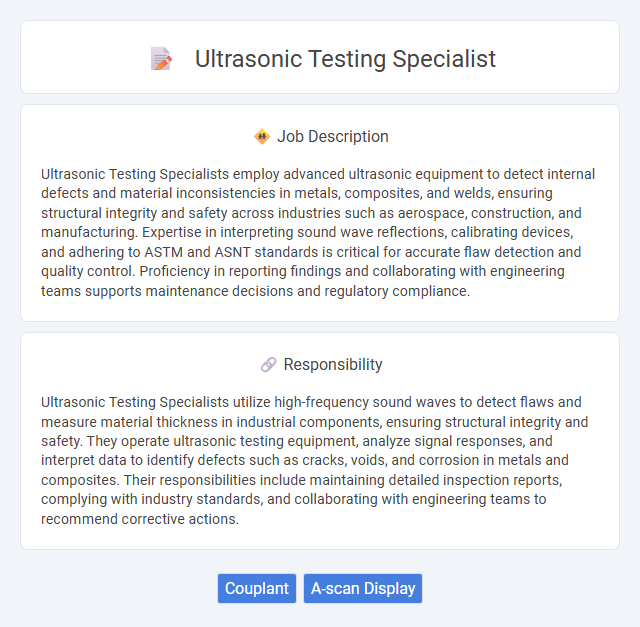
Ultrasonic Testing Specialists employ advanced ultrasonic equipment to detect internal defects and material inconsistencies in metals, composites, and welds, ensuring structural integrity and safety across industries such as aerospace, construction, and manufacturing. Expertise in interpreting sound wave reflections, calibrating devices, and adhering to ASTM and ASNT standards is critical for accurate flaw detection and quality control. Proficiency in reporting findings and collaborating with engineering teams supports maintenance decisions and regulatory compliance.
Ultrasonic Testing Specialists will probably require strong attention to detail and good hand-eye coordination to perform accurate inspections. Individuals who prefer routine and have a high tolerance for repetitive tasks may find this role suitable, while those who struggle with precision or discomfort working in industrial environments might face challenges. Physical stamina and the ability to work in confined spaces could also influence suitability for this job.
Qualification
Ultrasonic Testing Specialists must possess certification in nondestructive testing methods such as ASNT Level II or III, demonstrating proficiency in ultrasonic equipment operation and flaw detection. A thorough understanding of material properties, welding techniques, and industry standards such as ASTM and API is essential for accurate defect characterization. Technical skills typically include interpreting ultrasonic signals, calibrating testing devices, and preparing detailed inspection reports to ensure compliance with safety and quality regulations.
Responsibility
Ultrasonic Testing Specialists utilize high-frequency sound waves to detect flaws and measure material thickness in industrial components, ensuring structural integrity and safety. They operate ultrasonic testing equipment, analyze signal responses, and interpret data to identify defects such as cracks, voids, and corrosion in metals and composites. Their responsibilities include maintaining detailed inspection reports, complying with industry standards, and collaborating with engineering teams to recommend corrective actions.
Benefit
Ultrasonic Testing Specialists likely experience enhanced career opportunities due to the high demand for skilled professionals in industrial quality control and safety inspections. Their expertise may lead to competitive salaries and benefits, including job stability in sectors such as aerospace, manufacturing, and oil and gas. Proficiency in advanced ultrasonic technologies probably increases their chances for professional growth and specialized certifications.
Challenge
Ultrasonic Testing Specialists likely face challenges related to accurately detecting internal flaws in complex materials, which demands precise calibration and interpretation of ultrasonic signals. The probability of encountering varying environmental conditions could complicate testing processes, requiring adaptability and advanced technical skills. Continuous advancements in ultrasonic technology might also necessitate ongoing learning to maintain effective inspection methods.
Career Advancement
Ultrasonic Testing Specialists develop expertise in non-destructive testing techniques to detect material flaws and ensure structural integrity across industries like aerospace, oil and gas, and manufacturing. Career advancement opportunities often include roles such as Quality Control Manager, NDT Supervisor, or Technical Trainer, supported by certifications like ASNT Level II and Level III in Ultrasonic Testing. Mastery of advanced equipment and techniques, combined with ongoing professional development, significantly enhances prospects for leadership and specialized positions in the field.
Key Terms
Couplant
An Ultrasonic Testing Specialist expertly applies couplant materials to ensure efficient transmission of ultrasonic waves between the transducer and the test surface, which is critical for accurate defect detection in welds and structural components. Selecting the appropriate couplant--whether gel, oil, or water-based--depends on the material type, surface condition, and testing environment to optimize signal clarity and reduce attenuation. Mastery in couplant application directly impacts the precision of flaw characterization and the overall reliability of nondestructive testing results.
A-scan Display
Ultrasonic Testing Specialists utilize the A-scan display to interpret sound wave reflections and detect material flaws with precise depth and location data. This method provides real-time, high-resolution visualization critical for identifying defects such as cracks, voids, or corrosion in metals and composites. Expertise in analyzing A-scan signals enhances the accuracy of nondestructive testing in aerospace, manufacturing, and structural maintenance industries.
 kuljobs.com
kuljobs.com